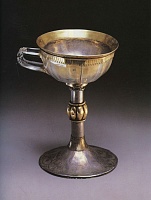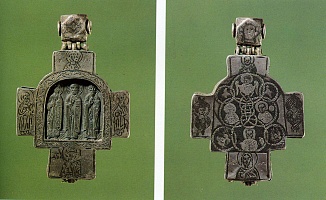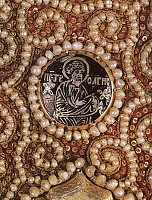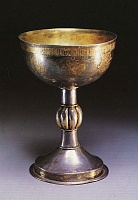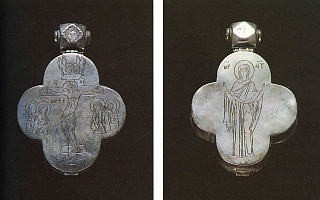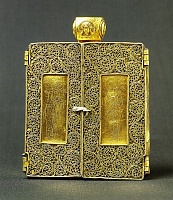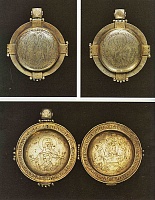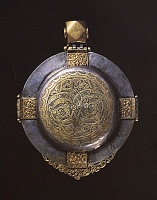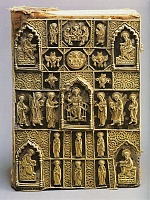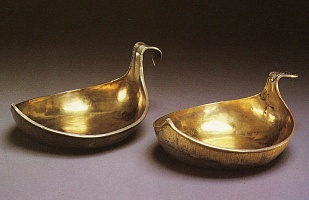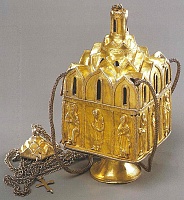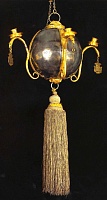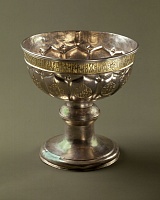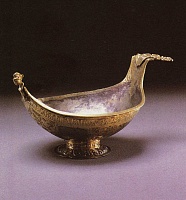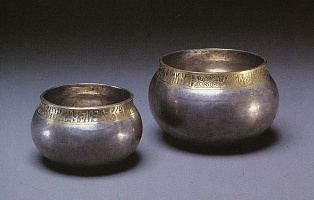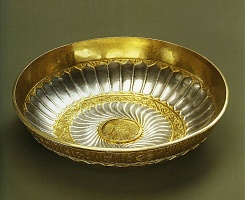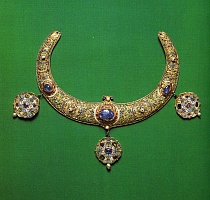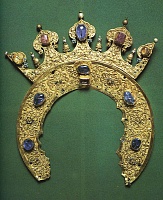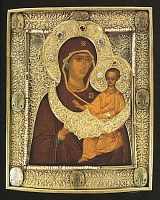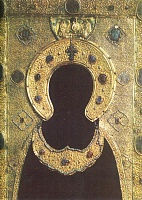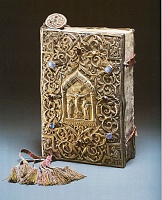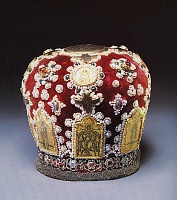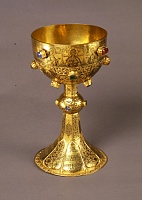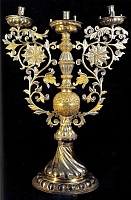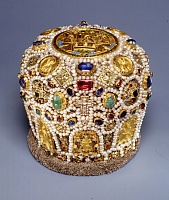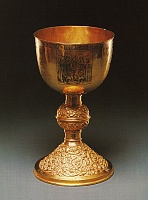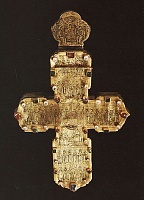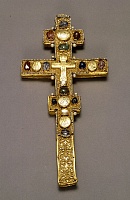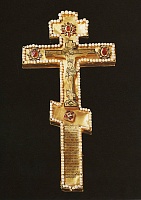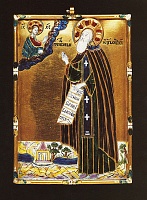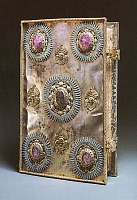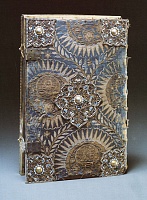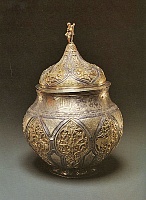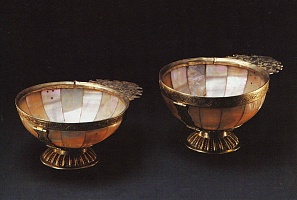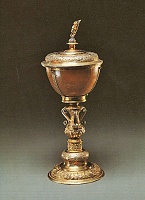Jewelry Art of the 14th – 17th cc.
The collection of jewelry art of the Sergiev Posad Museum gives a comprehensive idea of high skill of Russian craftsmen. The main part of the collection includes donations. They were usually church utensils, commissioned for the Monastery, or family relics ( silver vessels mainly) blessed by the ancestors and patrimonial legends of princes, boyars and servicemen.
The most valuable part of the collection presents works of early Moscow period of the 14th century. They show popular techniques and, at the same time, they illustrate the character of fine art of that time as nearly all of them are decorated by pictorial images. Among them is a rare silver chalice of the first half of the 14th century, presumably donated by boyar Dmitry Ivanovich Godunov.
Engraving was characteristic of Moscow art of the mid-14th century. It was sometimes combined with niello. These techniques were used for decoration of the cross-reliquary made by Semyon Zolotilov, a craftsman of Prince Dmitry Donskoi. On the sides of the cross the thick nielloed contour laid between two engraved lines depicts the saints: on the obverse – St. Georg and St. Demetrius (on the top and on the bottom), the Apostles Peter and Paul or SS. Cosmus and Damian (on the sides), on the reverse – the Virgin and St. John the Theologian (on the face planes of the sides), St. John Chrysostom and St. John the Baptist (on the top and the bottom), cherubs and saints (St. Nicholas with raised hands is recognized between them) in the circles and in the central part.
Engraving was characteristic of Moscow art of the mid-14th century. It was sometimes combined with niello. These techniques were used for decoration of the cross-reliquary made by Semyon Zolotilov, a craftsman of Prince Dmitry Donskoi. On the sides of the cross the thick nielloed contour laid between two engraved lines depicts the saints: on the obverse – St. Georg and St. Demetrius (on the top and on the bottom), the Apostles Peter and Paul or SS. Cosmus and Damian (on the sides), on the reverse – the Virgin and St. John the Theologian (on the face planes of the sides), St. John Chrysostom and St. John the Baptist (on the top and the bottom), cherubs and saints (St. Nicholas with raised hands is recognized between them) in the circles and in the central part.
Apart from Moscow works the Museum collection presents early Novgorod items decorated with filigree, engraving, casting, enamel. Round plaques of the last quarter of the 14th century, decorating the epitrachelion, are of special interest. They are decorated with chamfer enamel, the information of which has not survived.
Works of Moscow gold- and silversmiths of the 15th century in the Museum collection testify to the variety of shapes and perfect command of many techniques. Andrei Rublev style shows in the gilded engraved deesis depicting seven half-length images ( Christ, the Virgin, St. John the Baptist, Archangels Gabriel and Michael, Apostles Peter and Paul) on the bowl of the silver chalice of the first half of the 15th century, probably made by a Trinity craftsman.
Real masterpieces of jewelry art are the cross-reliquary with the Crucifixion – the Virgin Orans and the Trinity and panagia with the Savior Enthroned and St. Nicholas on the exterior parts, the Virgin of the Sign and the Trinity, repeating Rublev iconography, inside.
The Museum preserves superb specimens of Moscow silver castings of the fist half of the 15th century made in Moscow and the Trinity Monastery. The rare reliquary, which used to belong to the family of Radonezh Prince Andrei Vladimirovich and was most probably made between 1410 and 1429. Moscow art was always a kind of orienting mark for local artistic centers.
The Trinity silversmiths, casters in particular, quickly sensed its achievements. In the first quarter of the 15th century one of the Monastery craftsman possibly made the panagia that belonged to the Monastery hegumen Nikon. The precious Gospel cover of the late 15th century, originating from the Nikilo-Pesnoshsky Monastery, was very likely connected with the Trinity artistic workshops.
Russian silversmiths frequently used architectural models for their works. The earliest item of this type in the Museum collection is the censer, made, according to the inscription, “to the conception” of Hegumen Nikon in 1405. In the 15th century, complicated filigree flourished in Moscow. It was widely used in decoration of icon mountings, books, church vessels.
The gold chalice made by Ivan Fomin and donated to the Monastery by Grand Prince Vassili II in 1449. The gold setting of the carved wall-nut icon proofs the flowering of filigree in the 15th century. It was made in 1456 by Ambrose, a talented carver and skilful goldsmith.
The silver gilded dippers strike with exceptional beauty. Very few boatshaped dippers have survived. The earliest Russian dippers refer to the 15th century. They originated in Novgorod. However, ancient Moscow dippers do not differ greatly from Novgorod samples, which is proved by the dipper of boyar Pyotr Mikhailovich Pleshcheyev.
Тhe original chandelier of 1568 shaped like a silver sphere with four candlesticks in the form of gold snakes with a massive truss of twisted gold threads was donated by Tsar Ivan the Terrible. In 1564, Ivan the Terrible donated the large toasting cup in memory of his uncle Prince Vassili Mikhailovich Glinsky. The fine dipper of Princess Kilikia Ushataya bears a poetical on the rim: “This is a dipper to drink for health, praying to God, praising the Tsar, remembering the beloved fread”.
Loving cups of the 16th century from the Museum collection are referred to the earliest group in our country. Bowls and low cups with flat bottoms are ancient Russian drinking vessels. They are noted for their sizes and sometimes for flat handles-ledges. All surviving cups are not dated back earlier then the 16th century.
The Museum preserves rare loving cups of the 16th century which originally belonged to the Monastery Cellarer Eustathius Golovkin and Marfa Vladimirovna, the daughter of Prince Vladimir Andreyevich Staritsky. There are also various vessels including the bowl with the name of Tsarevich Feodor Ivanovich and cup of the Tsar groom Pyotr Nikitich Nikiforov with Samson tearing the lion’s mouth chased on the handle. All items are remarkable for their rational shapes and harmonious decoration.
The 16th century is a recognized heyday of Russian jewelry art. Moscow craftsmen took the leading place in the development and refinement of the ancient techniques: engraving and niello, filigree, chasing, enamel. The techniques acquired new qualities when they were combined in decoration of articles. Among of the best works of Moscow goldsmiths of the second half of the 16th century are fragments of the mounting for “The Old Testament Trinity” icon, donated by Ivan the Terrible, - the crowns, crescent collars with pendants, plaques with niello, small fragments of the chased plaques from the margins and from the background. Every detail of the mounting demonstrates the great skill. The crowns decoration is based on the effect of combination of glittering patterns and matted background. Thus the qualities of the precious metal are emphasized.
The mounting of the triptych, depicting the Petrovskaya Virgin and Metropolitans Peter and Alexius, is an interesting specimen of Novgorod filigree.
Chasing occupied a significant place in adornments of items made of precious metals. Its soft shining reliefs decorate book covers, icon mountings, all kinds of secular and church articles. The craftsmen preferred floral patterns. The ornaments are rhythmic, graphic and distinct. The mounting for the icon “St. Sergius of Radonezh”, made to the order of Tsar Feodor Ivanovich, is an outstanding work of the 16th century Moscow chasers. It was used as a cover for the shrine of Sergius.
There were skilful craftsmen in the Monastery too. They made a number of attractive items at the late 16th – early 17th century. The spherical chandeliers were commissioned by Cellarer Eustathius Golovkin and Marfa Vladimirovna Staritskaya. They were completely covered with a chased floral pattern and decorated with a sculptural dove. To some extent, the chandelier of 1568, presented by Ivan the Terrible, could be used as a model for them. The beautiful gospel cover was commissioned by the Monastery Cellarer Eustathius Golovkin in 1602.
The works of the late 16th – early 17th century jewelry art are magnificent and luxurious, like the mounting of the main Monastery icon “The Trinity of Old Testament”, made to the order of Boris Godunov in 1599 – 1600. In the subsequent centuries the mounting was supplemented. In 1626, Tsar Mikhail Feodorovich presented the crescent collars, made by German craftsmen Hast Jakub and Lenta Johan who used the crescent collars of Ivan the Terrible as a model. In the mid-18th century the gilded silver chasuble, blocking the icon, was made.
At the time of Boris Godunov engraving and niello was widely used together with chasing. The works of the Moscow Kremlin workshops were most decorative. Boris Feodorovich Godunov donated the Pearl icon-cloth, air “The Holy Trinity”, mitre, chalice of 1597, candlestick of 1599, gold plates, mounting for “The Trinity of Old Testament” painted by Andrei Rublev, decorated with nielloed plaques. Niello of the late 16th – early 17th century is very refined. The intricate engraved and nielloed floral pattern covers nearly the whole surface of the elegant chalice of 1597, presented by Boris Godunov, when he was a tsar stable boyar of Tsar Feodor Ivanovich.
The collection of the 17th century jewelry art is rich and varied. The mitre, donated to the Monastery in memory of Prince Feodor Ivanovich Mstislavsky by his wife and daughter. The main center of jewelry art was the Armory Chamber of the Moscow Kremlin. The gold- and silversmiths of the Armory Chamber developed the techniques of their predecessors. They made a lot of items to be donated to the Trinity-St. Sergius Monastery.
The silversmith Ivan Leontiev was commissioned by the Duma Deacon Ivan Tarasyevich Gramotin to produce gold liturgical vessels – chalice, discos and two plates. The fine nielloed miniatures decorate the gold lid of the large silver cross-reliquary donated to the Monastery in memory of I.T. Gramotin. The miniatures are in perfect harmony with the cross decoration – delicate pearls on gold holders on the lid edges are combined with emeralds, rubies and a sapphire fixed on the low end of the cross. The gold cross, made by Andrei Malov, is marked by an exceptional beauty. It is decorated with chased gold plaques with nielloed images, multi-colored stones and pearls.
The gold cross-reliquary was made in the workshops of the Armoury Chamber in 1678 to the order of Grand Princess Irina Mikhailovna and brought to the Monastery by Tsar Feodor Alexeyevich according to the inscription on the cross and the record in the Book of Donations of 1639. Enamel matched perfectly decorativeness and festivity of the 17th century applied art. Russian craftsmen could use in various ways. At the second half of the 17th century enamel frequently covered the whole figures of saints on different church objects. The small gold icon of 1667 with the enameled image of St. Sergius of Radonezh, donated by Boyar Bogdan Matveyevich Khitrovo, is a characteristic example.
Various enamels used in decoration of the luxurious cover of the printed Gospel, presented by Prince I.B. Repnin in 1695. The multi-colored painted floral ornament, framing the oval burs with pinkish-lilac Chinese stones with relief images – the Saviour Enthroned in the center and Evangelists in the corners of the gilded silver board. Blue and green champleve enamel covers the wings of chased cherubs around the central image. Multi-colored enamel fills the filigree pattern of silver figured plaques on the gold background of the back board of the cover.
Russian church and secular utensils of XVII century still keep traditional forms. However, in comparison with previous century their decorative furniture more richly. Quite often, their all surface decorated by the dense stamping or engraved ornament. Fine representation about such vessels gives “bratina”, enclosed in a monastery in 1633 by tsar’s clerk Feodor Apraksin. Along with the magnificent, elegantly decorated products in XVII century meets much and such where masters still prefer ancient traditions in processing of the form and revealing of features of a material. In addition, in this case separate elements of their decor eloquently testify to a spirit of the age.
Such is the massive forged sacred water’s bowl from silver, custom-made of Alexander Bulatnikov, cellarer of a monastery, in 1631. In an antiquity were appreciated very rare products from nacre and various ornamental stones. There are presents unique cups from nacre, small cups from onyx and cornelian. Their decorative qualities are in many respects defined by already materials which natural beauty become known even more brightly in a combination to skilful silver and gold frames. The cup concerns the rare products from a jasper, put in order by the stamping gilt silver, enclosed by cellarer of the monastery Simon Azaryin in 1650. The cover of the cup finished by a cast man's figure, probably, the West European work.









